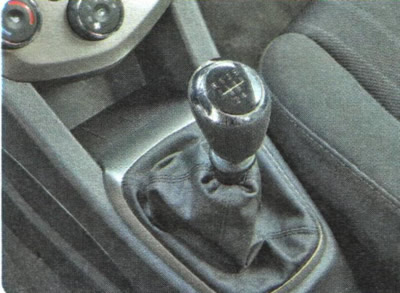
Manual transmission operate according to the switching diagram printed on the handle of its lever. In the neutral position, the lever is automatically set to the 3rd or 4th gear position, from which it can be moved forward or backward respectively. To engage 1st or 2nd gear, move the lever all the way to the left and then forward or backward respectively. To engage V gear, move the lever to the right as far as it will go and forward.
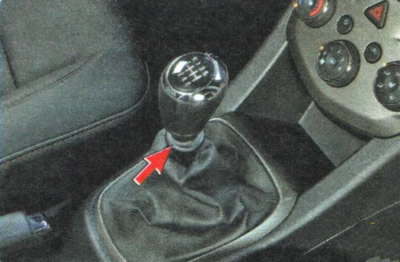
To engage reverse gear, lift up the lock ring (shown in the photo with an arrow), move the lever all the way to the left, and then forward.
Automatic transmission It has six forward gears and one reverse gear. The inclusion of each gear occurs automatically depending on the position of the gear selector lever, vehicle speed and the position of the accelerator pedal.
NOTE: During the break-in period of a new vehicle or immediately after connecting the battery (after disconnection or replacement) gear shifting may not be as smooth as usual. This does not indicate a malfunction: after several automatic gear shifts, the shifting process will become smooth.
In addition to the automatic control mode, a manual mode is also provided, in which the driver can independently quickly change gears by pressing the upper or lower edge of the button 2 (pic. 1.10).

NOTE: Unlike a manual transmission, an automatic transmission, when in manual mode, allows the driver to change gear without releasing the accelerator pedal.
The selector lever is located on the floor tunnel in the same place as the manual transmission control lever. A scale of 4 control modes is applied to the overlay of the floor tunnel. On the handle 3 of the lever there is a button 1 for blocking the inclusion of an inappropriate gear in automatic mode and a key 2 for shifting gears in manual mode.
The following designations are applied to the scale of control modes:
R (parking). In this position, the transmission is locked to prevent the parked vehicle from moving. If the selector lever is in this position, the engine can be started;
R (reverse). Move the lever to this position only after the vehicle has come to a complete stop;
WARNING: Never move the selector lever to the «R» (parking) or «R» (reverse) while driving! This will damage the gearbox.
N (neutral). In this position of the lever in the gearbox, no gear is engaged. This position is used during long stops (e.g. in traffic jams);
WARNING: Never move the selector lever to the «N» (neutral) while driving! In this case, you can accidentally move the lever to the position «R» (parking) or «R» (reverse), which will damage the transmission. In addition, engine braking will become impossible.
HINTS AND TIPS: To maintain control of your vehicle, always keep your foot on the brake pedal when the lever is in the «N» (neutral), as well as when moving the lever to this position.
If the car is on a slope, then when starting the engine, the selector lever must be set to the position «R» (parking), but not «N» (neutral).
D (forward movement). This is the main position of the selector lever, in which it is located most of the time when driving. In this case, the automatic transmission selects the gear that is optimal for a given speed and acceleration of the car. When driving on a steep descent, a downshift may automatically be engaged to provide more effective engine braking;
M (manual control mode). In this position of the selector lever, the driver changes gears independently by successively pressing the upper edge of button 2 (upshifting) or on its lower edge (downshifting).
To move the selector lever from position «R» (parking) into position «R» (reverse) press the lock button 1 located on the handle 3 of the lever while simultaneously pressing the brake pedal.
NOTE: A special locking device will not allow the selector lever to be moved from the position «R» (parking) to any other position if the brake pedal is not held down.
To further move the lever to the positions «N» (neutral) And «D» (forward movement) You don't need to press the lock button. To move the lever back from position «D» into position «N» the lock button does not need to be pressed, and to further move the lever to the positions «I» (reverse) And «R» (parking) button should be pressed. To move the lever to position «M» (manual control mode) press the lock button. To move the lever back from position «M» (manual control mode) into position «D» (forward movement) You don't need to press the lock button.
WARNINGS: Do not press the lock button each time the selector lever is moved from one position to another. This will become a habit and you can move the lever to the «R» (parking) or «R» (reverse) while the vehicle is moving, which will damage the transmission.
When starting a movement, do not press the accelerator pedal when moving the selector lever from the position «R» (parking) or «N» (neutral) to some other position. This is dangerous as the vehicle may move suddenly forward or backward.
When the ignition is on, the display of the instrument cluster shows the designation of the position of the selector (automatic switching mode) or the number of the included gear (manual switching mode).
Whether the vehicle is moving or stationary, to select manual shift mode, move the selector lever from the «D» (forward movement) into position «M» (manual control mode) to enable manual shift mode. In manual transmission control mode, you can quickly change gears by pressing the upper or lower edges of button 2 without releasing the accelerator pedal.
To shift to a higher gear, press the top edge of the key marked with «+», and release the key. To switch to a lower gear, press the lower edge of the key marked with the symbol «-», and release it.
WARNING: In manual transmission mode, upshifting does not occur automatically. It is up to the driver to determine when to shift into a higher gear according to road conditions. In this case, it is necessary to ensure that the engine speed does not exceed the maximum allowable value (the tachometer needle did not enter the red zone of the scale).
NOTES: In manual transmission mode, only one of the six forward gears can be selected. To drive in reverse or park, move the selector lever forward to auto mode and then to «R» (reverse) or «R» (parking) respectively.
To ensure the necessary traction and dynamic characteristics and vehicle safety, the automatic transmission may not shift to a higher gear at insufficient vehicle speed, even if the driver presses the edge of the button marked with the symbol «+». Similarly, the transmission may not downshift at high speed even if the driver presses the lower edge of the button marked with «-», to prevent excessive engine speed increase.
In manual transmission control mode, when the vehicle speed decreases, downshifting occurs automatically. When the car stops, 1st gear is automatically engaged. Move the selector lever smoothly, without excessive force. Sharp and strong movements can damage the lever.
In the event of a discharge of the battery or a malfunction of the electrical equipment to unlock the automatic transmission (moving the selector lever from position «R») perform the following operations.
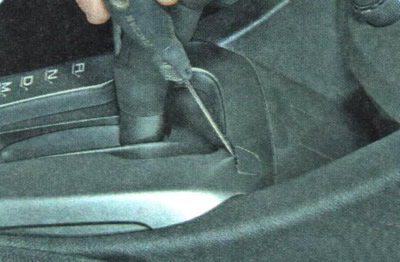
1. Prying with a flat blade screwdriver...
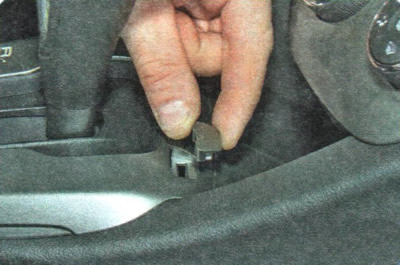
2.... remove the plug from the hole in the lining of the selector backstage.
3. Press and hold the brake pedal.
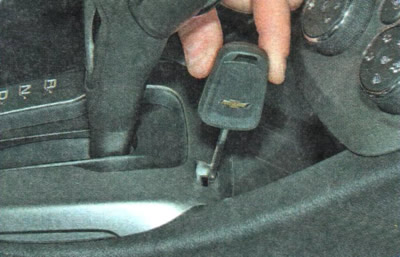
4. Insert the key for the lock into the hole in the lining of the backstage (switch) ignition (or screwdriver)...
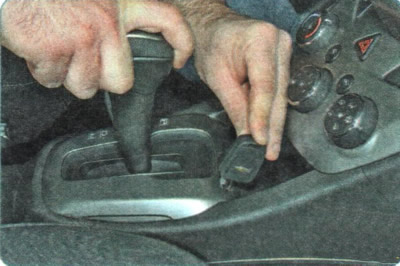
5.... press it on the release lever in the downward direction and move the selector lever from the position «R», for example, in position «0» or «N», by pressing button 1 (see fig. 1.10) blocking.
6. Contact an Authorized Chevrolet Dealer to have the locking system checked.
